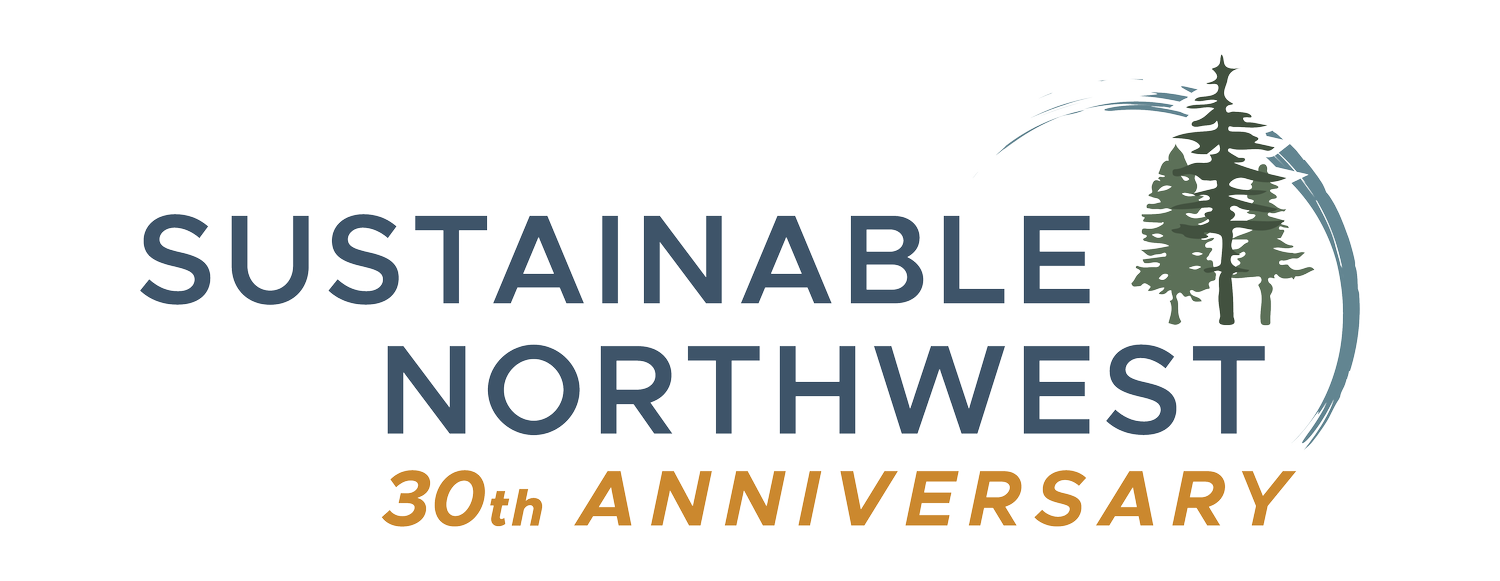Niche Market Development for Western Juniper
As printed in the Winter 2017 issue of Northwest Woodlands Magazine

In the late 1800s, pioneers that arrived to settle in central and eastern Oregon, southeast Washington, northern California, and southwest Idaho saw a very different landscape than the one we know today. Rolling grasslands and sagebrush steppe provided adequate breeding habitat and forage for wildlife species like mule deer and sage grouse. Only the occasional Western Juniper tree was visible on the ridgelines.
Following this time, a period of overgrazing of domestic livestock compounded by federal fire suppression policies allowed the tree to thrive. Western Juniper (Juniperus occidentalis) is a natural survivor and is well adapted to the high desert. Wildfire is its only natural predator, and without a regular fire cycle to clear out new seedlings, its presence has increased exponentially over the past 150-180 years from its historic recorded range of 1 million acres to nearly 9 million acres today.
New studies of sage grouse are showing the impact of juniper encroachment on nesting behavior. Predators perch on juniper, and researchers from University of Idaho and the Natural Resource Conservation Service (NRCS)-led Sage Grouse Initiative found that hens avoided nesting where conifer cover exceeded 3% within 800 meters of their nests. Due to a significant decrease in habitat, in 2015, the bird came close to being added to the threatened or endangered species list.
Juniper also has a significant impact on soil moisture and groundwater. Long-term hydrological studies being performed in the Camp Creek Watershed, about 60 miles southeast of Prineville, Oregon, show an average 3 to 4 gallons per minute return of spring flow outputs after juniper removal. In the 60-day dry season, that adds up to nearly 260,000 gallons of additional water that is available for livestock, fish, or plant growth along the stream channel.
Western juniper is considered a native invasive, and there is widespread agreement that juniper needs to be thinned for grassland and hydrological benefit, wildfire risk reduction, as well as species diversity. However removal of acres of juniper is a costly endeavor in the absence of a commercial market for the wood.
For decades, there had been interest in developing a market for juniper to help fund landscape restoration work, but past efforts were unsuccessful. Landowners recognize that cost share dollars from state and federal agencies like Oregon Watershed Enhancement Board or NRCS that are used to fund juniper removal projects could be at risk of drying up, or are generally insufficient to treat all the acres of juniper. The common belief was a robust market could supplement or ultimately replace the need for public funding.
In 2011, the steering committee of Oregon Solutions, a state-backed organization that develops collaborative triple bottom line solutions to community-based problems, sought to reinvigorate interest in a juniper market. They saw the opportunity to educate consumers by rebranding products as sourced from “restoration juniper”.
Discussions kicked off an assessment of the current status of juniper in Oregon and the perceived challenges and opportunities to successful utilization of the available resources. The main issues and challenges identified were supply, technical information -- specifically the inventory of trees across eastern Oregon -- and the need for products and market development. They involved the Bureau of Land Management (BLM) and the Association of Oregon Counties in the discussions, which culminated in an Oregon Solutions project designation by former Oregon governor John Kitzhaber in August 2012. With this, the Western Juniper Utilization Group (WJUG) as it was initially dubbed -- a unique and cohesive partnership of state and federal agencies, academics, wood products businesses, non-profits, landowners, and funders -- was formed. One year later, the 29 WJUG member groups signed onto a Declaration of Cooperation agreeing to create a scaled-up juniper restoration economy, and recommend solutions to key technical, social, and policy barriers through this shared commitment.
Sustainable Northwest was selected to house the project and act as the coordinating hub for the group, renamed the Western Juniper Alliance (WJA), as well as take lead on fundraising and policy advocacy for the initiative. To date, nearly $2 million has been raised for market and supply chain coordination, business development, product promotion, and research and development.
Part of these state and federal dollars are funding a study of lumber grades and engineering design values of Western Juniper. The lack of published data on these values up to this point has stunted market development efforts, as public and private engineers and architects looking to use the wood for structural applications are often forced to specify other wood species for which technical data are available. The study is currently underway at the OSU Oregon Wood Innovation Center. Mechanical property testing of the wood was completed in September of this year, and results are expected in the coming months.
The balance is going to training programs for workforce development, technical and business assistance, a mapping analysis to identify the supply of juniper and inform future public and private land management needs, a loan and grant program called the Western Juniper Industry Fund that provides investment and working capital for juniper business expansion projects, and ongoing support of the WJA. This project was funded in part through two complementary bills that passed the Oregon state legislature in July 2015, an effort that was highlighted at the 2014 Oregon Business Summit. As a result of this funding, two new juniper milling businesses have started up, with more in development.
In 2014, the primary focus of the WJA was to grow market demand. Sustainable Northwest launched a brand and marketing campaign to build more market awareness and increase demand for juniper products. The heartwood is valued for its chemical properties that make it highly durable and resistant to rot or insect infestation, and a suitable local alternative to cedar, redwood, or pressure treated wood. Since the wood was primarily being used in outdoor applications in Oregon and Washington, the demand during the rainy winter season slowed. Suppliers and distributors saw the need to expand beyond the Pacific Northwest to markets with year-round application. California was the obvious next step for distribution, and sales there are growing. Sustainable Northwest Wood, a subsidiary wood warehouse business of Sustainable Northwest, has filled an important gap in the demand market by providing distribution and market outreach. By reaching out to new audiences like home and garden landscapers, organic vineyards and wineries, and home furnishing showrooms, they are educating consumers about the benefits of the wood and the benefits of harvest. Sales of juniper have grown 50% in the last two years, and that increase is projected to continue.
Two years later, the challenge is consistent supply; a critical issue that has been identified as a factor in juniper market development for decades. The irony is there are millions of acres of juniper ready to be cut for restoration projects, however experts estimate only 10% of the trees are suitable for milling. Old growth trees are off limits for harvest, and the remaining distribution of suitable trees is widespread across the vast area. Landowners also often rely on state and federal funding to manage juniper on their properties, and those that do are not always aware of market opportunities to remove saw logs.
Climate has also played a significant role recently in available supply. Last year, eastern Oregon experienced compounded difficulties that proved to be the final straw for one Oregon juniper miller who went out of business because he wasn’t able to procure logs. A long fire season and the subsequent pine salvage operations had loggers and trucks tied up in the fall, and a prolonged wet winter prevented trucks from accessing juniper on public and private roads.
The supply shortage affects the logger as well; if he isn't able to sell logs to a miller, he's not able to pay his fuel and equipment bills. This has become a circular problem the WJA is trying hard to address. In fact, the problem has been discussed so much that some Alliance members are tired of hearing the “chicken and egg” metaphor used to describe the situation: loggers need a dependable number of millers to sell to before they can grow their numbers, and millers need a dependable number of logs from loggers before they can grow their businesses.
To overcome these barriers, Sustainable Northwest will be hiring a part-time forester to coordinate the supply chain and ensure a consistent flow of material from landowners to the mills. They will identify current and upcoming harvest operations, broker log agreements, and connect all the relevant parties to increase capture of logs from restoration activities. Doing so will retain and create manufacturing jobs and provide greater confidence to distributors as they seek to grow the market in new states and sectors.

Juniper is a specialty species that defies the conventional lumber manufacturing model used to produce and sell commodity products like fir or pine. The tree grows with gnarled, twisted trunks and branches, and deeply grooved bark and dense knots, making it very difficult to mill, with a lot of bark-embedded waste material that is not suitable for common byproducts like chips for paper or particle board.
However, for many of the same reasons the wood is hard to work with, it makes for a beautiful product for those who can successfully tackle the challenge of milling it. Its warm tones, alluring scent, and unique shapes and textures lend itself well to rustic furniture designs and attractive features in finer grade lumber. In addition to exterior landscape and decking products, builders are also sourcing for new uses like interior cabinetry and paneling, countertops, and flooring.
Juniper is unlikely to become a commodity product due to the challenging nature of the milling and the low yield from juniper woodlands compared to traditional forests. To make a viable juniper market at a quasi-craftsman-industrial scale that supports restoration activities will require a strong business sense on the manufacturing side. In most cases, the complexity and challenge of coordinating everything from raw material, to marketing, state and federal regulations, employee relations, state employment divisions, workforce compensation, unemployment claims, and a reliable supply chain, all while running day-to-day manufacturing operations is overwhelming for some small businesses.
The BLM Boise Idaho District is also seeking a local market for early phase juniper to help incentivize further sage grouse habitat restoration projects, and utilize trees that are currently being burned in slash piles. They have a working group in place to look at potential methods of harvest that would make it economical for market and attractive to potential juniper business investors. However, the role the BLM can play is limited. They need a local champion to drive the market development, and right now progress is stalled. The BLM sees the progress Oregon has made, and is optimistic that juniper biomass energy development could work in Idaho if the processing of feedstock can happen locally. The engineering design values study shows a promising potential niche market for them as well; the Idaho Department of Transportation has expressed interest in the idea of juniper road sign posts. If projects pencil out economically, the BLM is optimistic that Owyhee County could get behind a juniper market.
Despite the variety of challenges to market growth in Oregon, stakeholders remain persistent in their efforts, emboldened by progress on the near horizon. Supply chain coordination is underway. Biomass energy products are in development that may broaden the market for non-millable juniper. And state procurement of juniper for roadway signs and guardrail posts are poised to take off once the engineering values results are published. With all of these pieces in place, there is a sound model for a juniper market that other states can replicate, for the benefit of the land, the wildlife, and the people.

Project Support
Find local sustainable wood products in Portland Oregon

Our Why
We exist to promote Good Wood in the Pacific Northwest and beyond
Sustainable Northwest Wood
2701 SE 14th Ave.
Portland, OR 97202
Monday - Friday
8am to 5pm

© 2025 Sustainable Northwest Wood

Our nonprofit parent company is Sustainable Northwest